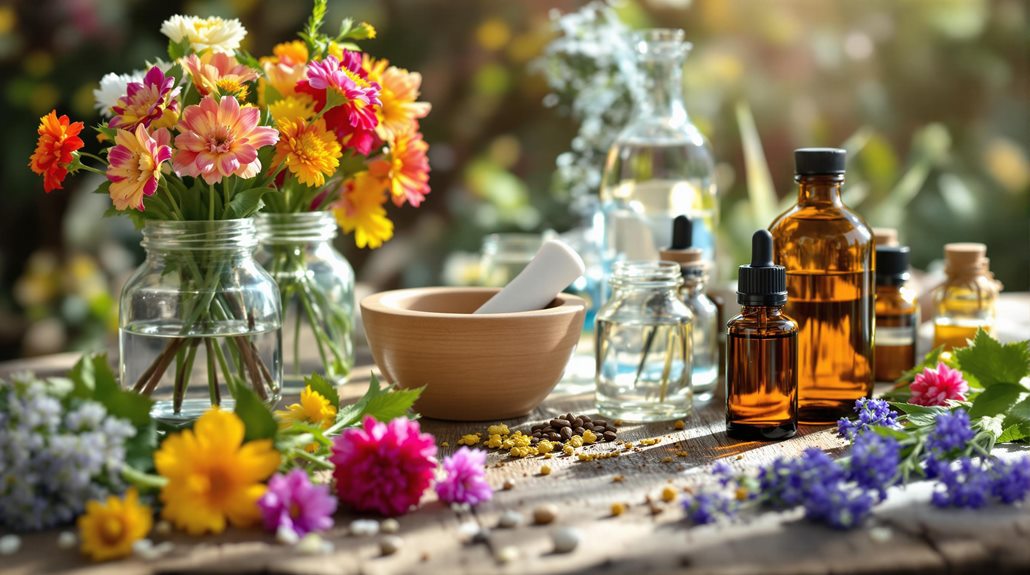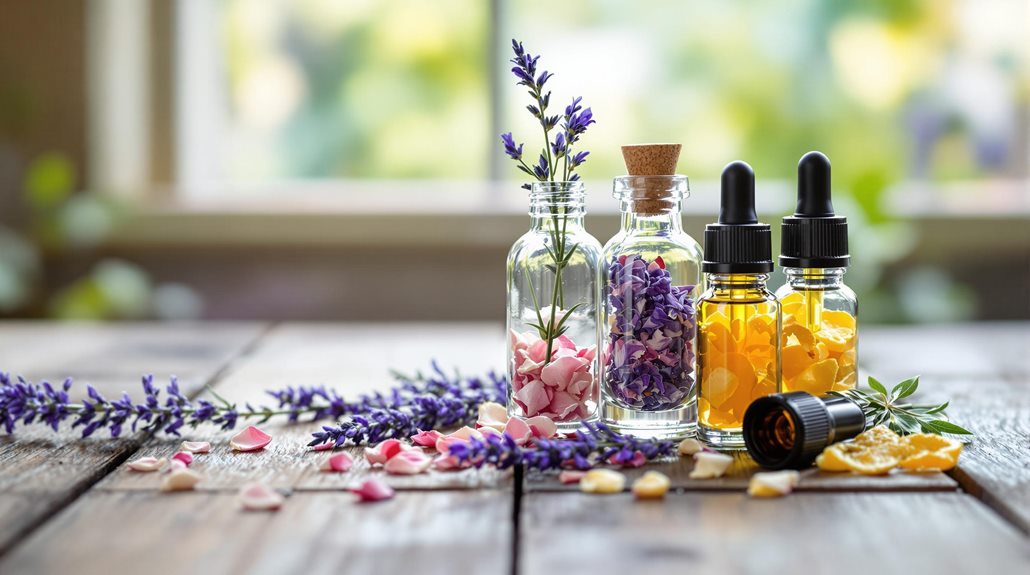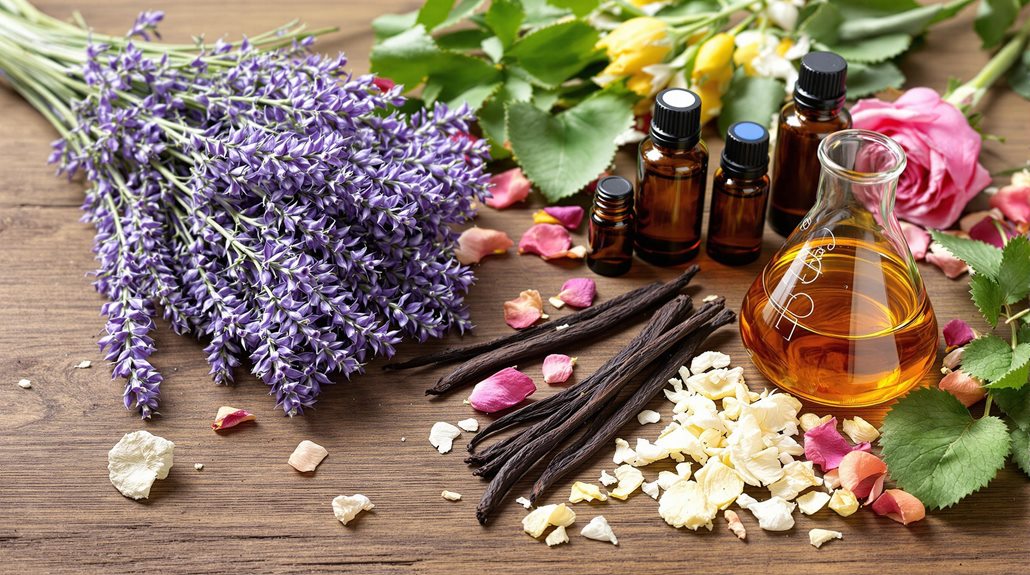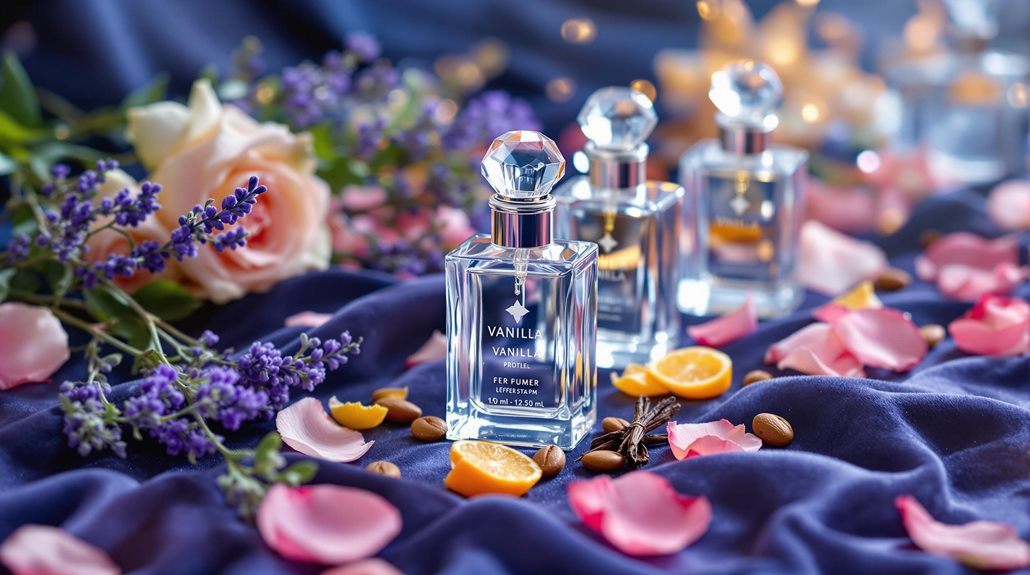How to Decant Perfume: Step-by-Step Guide to Fragrance Portability
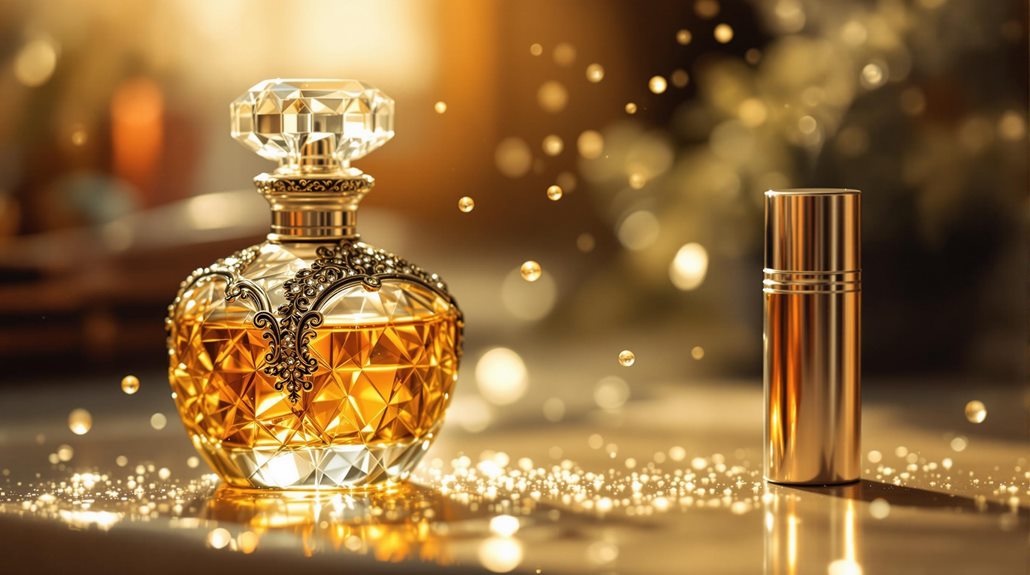
To decant perfume, you'll need clean glass bottles, a small funnel, and pipettes or droppers. Start by sanitizing all your tools and workspace in a well-ventilated area. Remove the spray nozzle from your original perfume bottle, then carefully transfer the fragrance into your travel-sized container using your chosen method - either pouring through a funnel or using a pipette for more control. Don't overfill; leave adequate headspace to prevent leaks. Label your new bottle with the fragrance name and date, then store it in a cool, dark place. Following proper techniques will guarantee your precious scents maintain their integrity.
Understanding Perfume Decanting Basics
With safety and precision in mind, decanting perfume involves carefully transferring fragrance from its original bottle into a smaller container. This process lets you carry your favorite scents in travel-friendly sizes while preserving the integrity of the original fragrance. When you're decanting perfume, you'll need clean, airtight containers specifically designed for holding fragrances.
Before you begin decanting, gather essential supplies: small glass bottles with secure caps, a clean funnel, pipettes or droppers, and latex gloves to protect your hands. The receiving bottles should be dark-colored or opaque to shield the perfume from light damage. You'll want to make certain all your tools are completely clean and dry, as any moisture or residue can alter the fragrance's composition.
Understanding the basics of perfume preservation is vital for successful decanting. Fragrances are sensitive to heat, light, and air exposure, so you'll need to work in a cool, well-ventilated area away from direct sunlight. It's important to minimize the perfume's exposure to air during transfer, as oxygen can degrade the scent compounds and alter the fragrance's character over time.
Essential Tools and Materials
Assembling the right tools is essential for successful perfume decanting. You'll need several vital items to guarantee a clean, precise transfer of your fragrance from one container to another. Glass bottles should be your first choice, as they provide superior protection against light and air compared to plastic alternatives, and you can reuse them multiple times.
To properly decant your perfume, you'll need a small funnel to prevent spills and ensure accurate pouring. A tube dispenser helps with controlled transfers, while a syringe or pipette allows for precise measurements of your fragrance. Don't forget to prepare clean labels to mark your decanted bottles with important information like the perfume name and date.
Cleaning supplies are indispensable for maintaining hygiene throughout the process. You'll want to thoroughly sanitize all your tools and bottles before beginning. Make sure your vessels are completely sealable to protect the fragrance's integrity during and after the decanting process. While decanting for personal use is generally acceptable, remember that selling decanted perfumes might require specific permissions. These tools not only make the process easier but also help guarantee your decanted fragrances maintain their quality.
Popular Decanting Methods
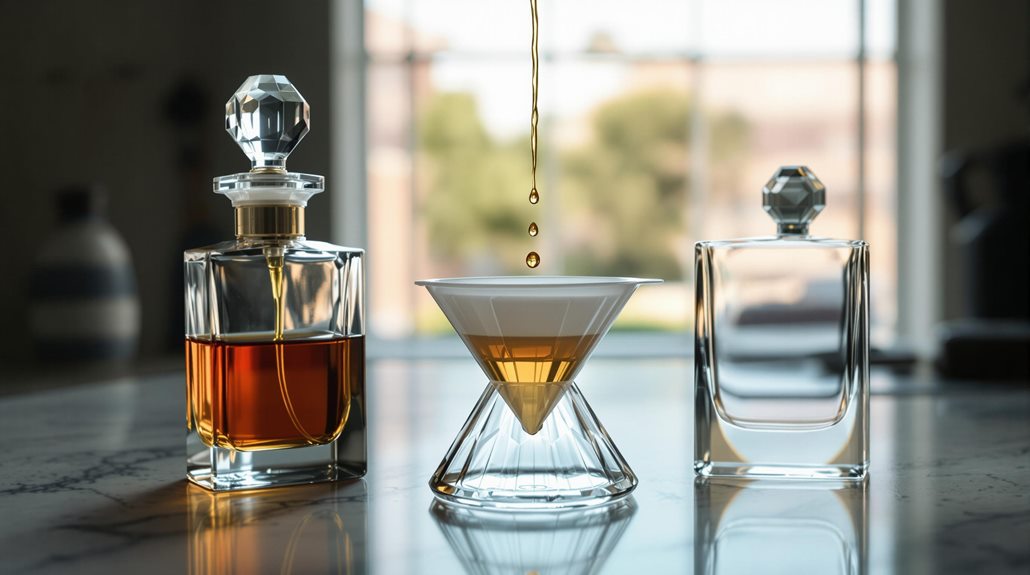
Once you've gathered your tools, you'll find several reliable methods to transfer your perfume. The most common decanting process involves using a small funnel to carefully pour the perfume from its original bottle into your travel atomizer. Place the funnel securely in the new container's opening and slowly transfer the fragrance, ensuring there's no spillage.
Another popular method is the spray-to-spray technique. Remove the spray nozzle from your travel atomizer, place it directly against the original perfume's nozzle, and spray repeatedly until you've reached your desired amount. This method works best with GLASS OR PLASTIC atomizers that have removable tops.
For vintage perfumes without spray mechanisms, you can use pipettes or plastic transfer pipes. Gently squeeze the pipette's bulb, insert it into the original bottle, and release slowly to draw up the perfume. Then, carefully pour the perfume into your new container. This method offers precise control but requires a steady hand.
If you're working with roller bottles, simply remove their ball tops using tweezers and transfer the fragrance using your chosen method, then replace the ball top securely.
Safety and Storage Guidelines
Safety precautions play a pivotal role in successful perfume decanting. When handling fragrances, you'll need to work in a well-ventilated area to avoid inhaling concentrated vapors directly. If you have known allergies or sensitivities to certain fragrances, it's critical to take extra precautions or consider wearing protective gear during the decanting process.
Maintaining a clean workspace is non-negotiable. Before you begin, ensure all your decanting tools and containers are thoroughly sanitized to prevent contamination. When choosing containers for travel, opt for high-quality PLASTIC or glass vessels that seal tightly to prevent leakage.
Proper storage is indispensable for preserving your decanted perfumes. Keep them away from direct sunlight, as UV rays can alter the fragrance composition and degrade the scent. Store your bottles in a cool, dry place with consistent temperature to maintain their quality. You'll also want to label each decanted bottle immediately with essential information, including the fragrance name and decanting date. This practice prevents mix-ups and helps you track the age of your decants, guaranteeing you're using them while they're still fresh.
Best Practices For Clean Transfers
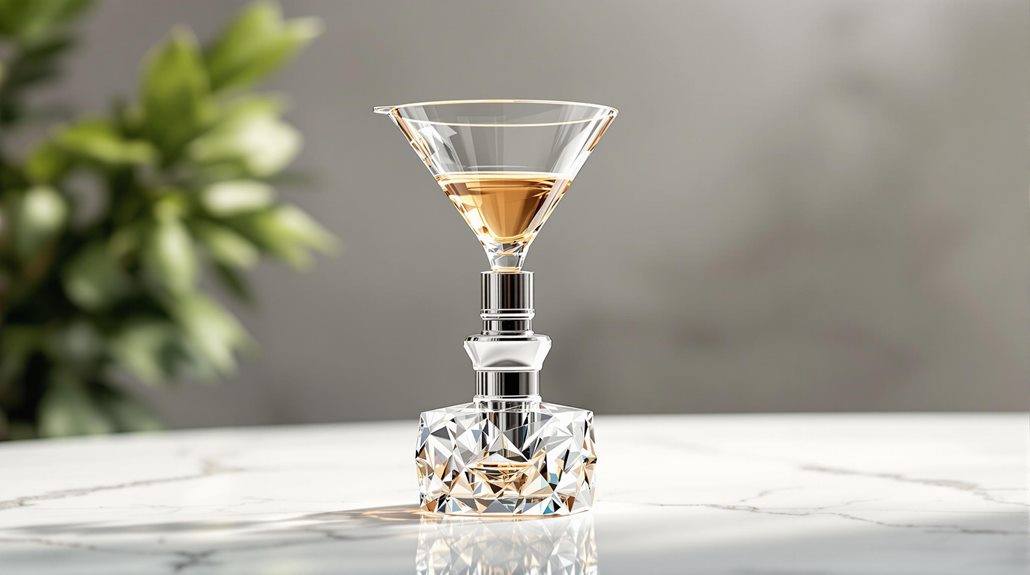
With your workspace and safety measures in place, commanding clean transfer techniques will set you up for successful perfume decanting. Start by thoroughly sterilizing all your glass equipment, including bottles, funnels, and pipettes. This pivotal step prevents any bacterial contamination that could alter your fragrance's composition.
Choose a well-lit, clean workspace where you can focus on the task without distractions. Keep separate tools for each perfume you're decanting to avoid mixing different scents. When you're ready to transfer, hold the funnel steady and pour the fragrance slowly into your decanted container. Remember to leave adequate headspace at the top, especially if you're using a spray bottle, as this prevents overflow and guarantees proper atomizer function.
Once you've completed the transfer, seal the container immediately and firmly. This step is indispensable in preventing evaporation and maintaining the perfume's integrity. Don't forget to label your newly decanted bottle with essential information, including the fragrance name and decanting date. These details will help you track your collection and ensure you're using the freshest possible scent.
Choosing The Right Containers
Selecting appropriate containers stands as the foundation of successful perfume decanting. When choosing your vessels, you'll want to prioritize glass bottles over plastic options, as they provide superior protection against light and air while maintaining your fragrance's integrity. Glass atomizers, in particular, offer the best longevity and help preserve your perfume's quality over time.
To guarantee you're making the right choice for your decanting needs, consider these essential factors:
- Glass bottles prevent contamination issues that commonly occur with plastic containers
- High-quality decanting bottles from reputable suppliers like Accessories for Fragrance safeguard better preservation
- Glass atomizers maintain fragrance integrity and offer better reusability options
You'll find excellent container options through trusted suppliers such as Lotioncrafter and New Directions Aromatics, which specialize in quality decanting supplies. Remember that while plastic containers might seem convenient, they're not ideal for precious fragrances and can compromise the scent over time. When investing in your decanting equipment, focus on acquiring proper glass vessels that will protect your fragrances and maintain their original characteristics throughout their use.
Common Decanting Mistakes
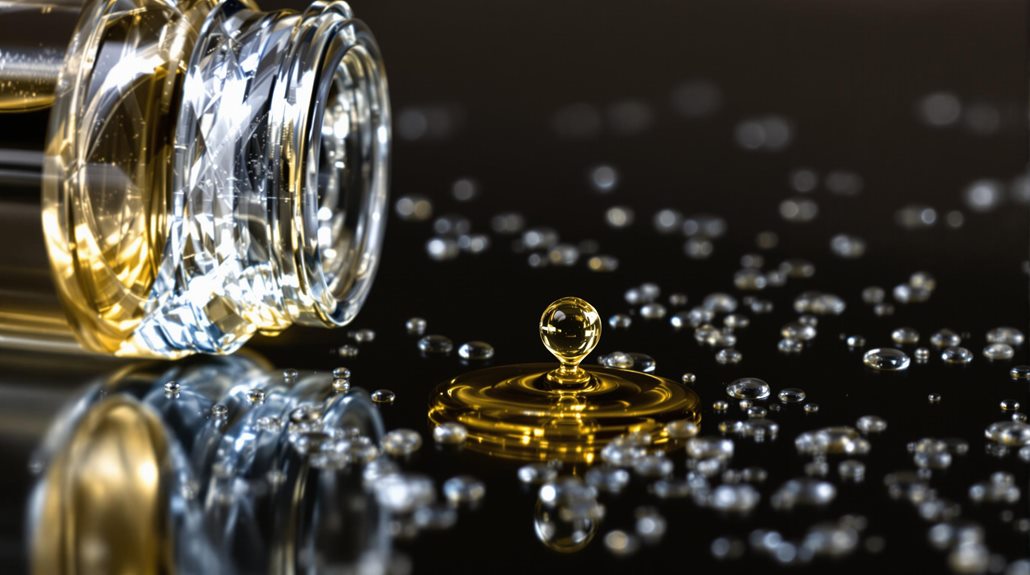
Commanding the art of perfume decanting requires avoiding several common pitfalls that can compromise your fragrance's quality and longevity. When filling your decanting bottle, don't make the mistake of overfilling it - leave adequate headspace to prevent leaks and spills that could waste your precious perfume.
Cross-contamination is another central issue you'll want to avoid. Using the same funnel for multiple fragrances will mix scents and alter their original compositions. Instead, dedicate a separate funnel for each perfume you're working with. Before you begin the decanting process, remember to remove the sprayer mechanism from the original bottle to safeguard a clean transfer without mess.
Proper labeling isn't just about organization - it's essential for identifying your decanted perfumes correctly. Don't skip this key step, as unlabeled bottles can lead to confusion and frustration. Additionally, pay attention to your storage choices. Light and air are enemies of fragrance preservation, so avoid clear bottles and direct sunlight exposure. Instead, opt for dark or opaque containers and store them in a cool, dark place to maintain your perfume's integrity.
Conclusion
Now you're ready to decant your favorite fragrances with confidence. Remember to work in a clean, well-ventilated space and always label your decants with the fragrance name and date. You'll find that mastering the art of perfume decanting not only makes your scents more portable but also helps preserve your precious fragrances. With practice, you'll become more efficient at transferring without spills or waste.

